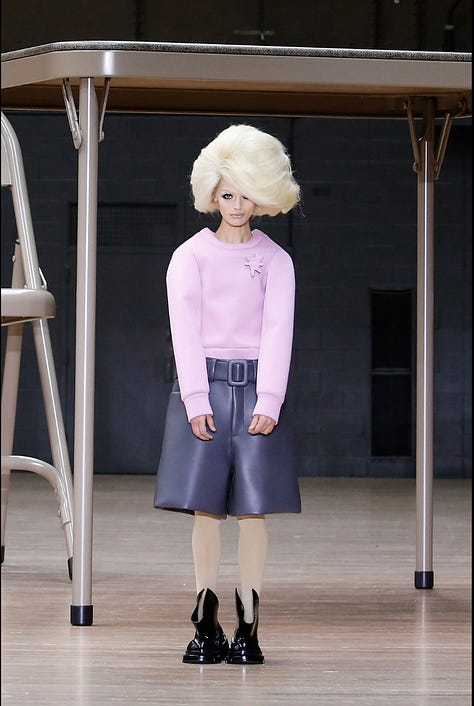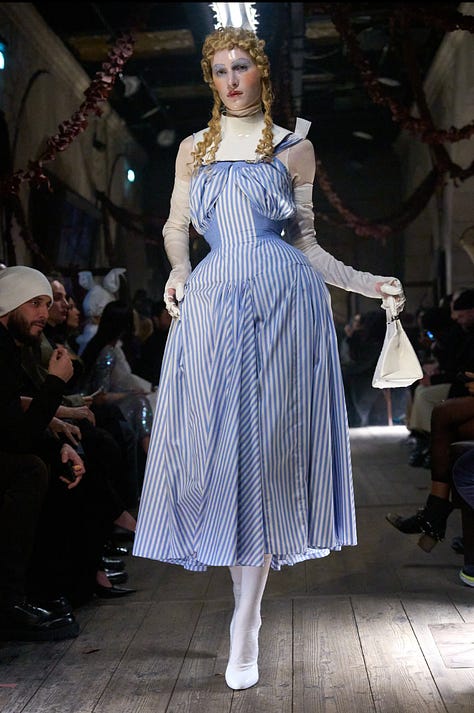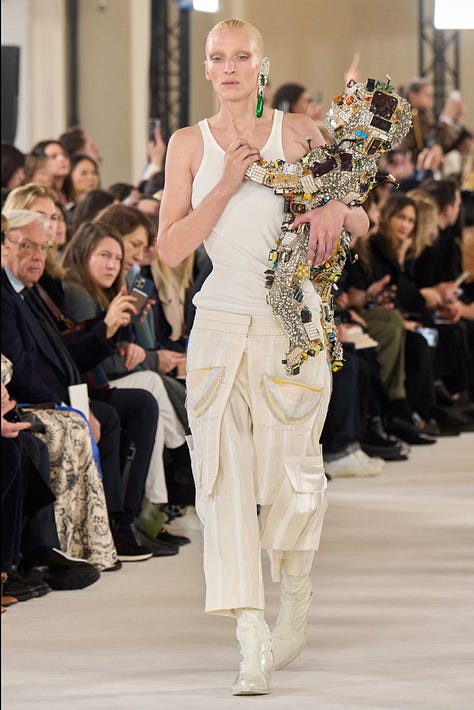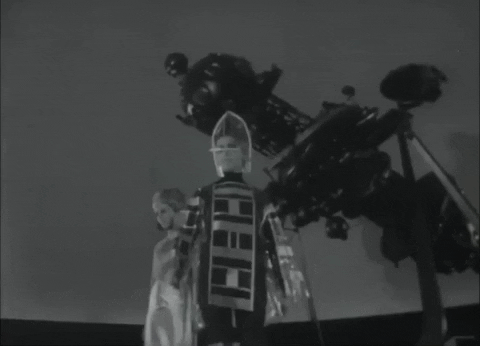Revenge of the Dolls
Fashion is sailing on a playtime high — fiction has been doing this for years. Why?
After a few relatively dull and redundant seasons, it appears that capital-F fashion is back. The couture shows, which occurred last week, were rife with compelling storytelling, feverish drama, and well, dolls. Lots of ‘em. On Saturday, Marc Jacobs commemorated the 40th anniversary of his namesake line, featuring a full-blown playtime set, oversized furniture and trompe l’oeil outfits worn by models who resembled cut-out dolls of midcentury vintage. What does this have to do with fiction? Wrong question, True Detective character and definitive non-doll, Captain Danvers might warn.








Fashion and fiction have long engaged in a clumsy part de deux. Designers have frequently pulled from novels to inform collections — going so far as to even print prose on garments. But the most recent collections are notably grimmer, flipping over a plaything and ripping at the seams to uncover what’s held within its softly bloated belly. And while fashion designers will continue to eye one another from the sandbox, there’s something bigger at play here. Fashion is investigating a trope often untangled in literature: From Frankenstein’s monster to the American Girl series and sci-fi cyborgs, dolls have served as a stand-in for feminism — and its counter resistance — for centuries.
So why has current culture moved into the dollhouse? That might be a better question, per Danvers. Dolls, regardless of their various versions, are blank slates for us to project fantasies and narratives. We play house and war. Practice mothering skills and sharpen battle tactics. That’s why, not dissimilar from the dolls who rambled down the runway for the epic Maison Margiela couture show (a must watch, no matter who you are), the concept of dolls awaking in the middle of the night is so fascinating. Who are dolls, really, when we remove ourselves from the story? What is a toy’s story?
There’s a scene in Mary Shelley’s “Frankenstein” when Dr. Frankenstein has succeeded in his morbid experiment: The monster is alive. It is the grotesque realization of his experiment’s success and absolute calamity that causes the doctor to reject the monster, spurring it to seek revenge. After an intense man (monster?) hunt, Frankenstein’s creation meets his end. It would suggest, then, that a doll’s life is in the palm of its owner, or creator’s, hand.
“Frankenstein” is a story of a doll that comes to life with awful repercussions. It suggests what might happen, if yes, a scientist’s hubris gets in the way of logic, but also what could occur to a doll who chafes with conformity. It all comes down to who’s holding the strings.
The England that Mary Shelley first wove her tale, and then published it, was one of early suffragist movements. It was printed in 1818, the same year as “A Plan for Parliamentary Reform,” which suggested that some women ought to have more rights than they were currently imbued with. That same year, certain female constituents were granted the right to vote. The fact that Shelley herself was able to publish such a controversial novel earns further high marks for progress. Now, women are free to vote (if they can get to a polling station), and create even more controversial stories.
And yet currently, many U.S. women are living through a societal whiplash, like a babydoll shaken in a toddler’s fist during a tantrum. On the one hand, women are outpacing men in many arenas. They’re completing college at higher rates and have upward mobility opportunities unlike any previous generations. A film about the most famous doll around can kick ass in the box offices and get kinda snubbed at the Oscars. And devastatingly, despite the fact that maternal mortality is on the rise in the U.S., many in certain states could be forced to carry to term, risking their lives in the process. And, even if they do have a child — no matter the circumstances or methods — they aren't granted paid time off to care for their infant, potentially putting at risk their child’s development, and possibly stunting their own professional growth. It makes “Rosemary’s Baby” look like a walk in the park.
Maybe life would be easier to give up free will as if we were dolls, available for those in power to play with as it suits them. There’s plenty out there who would certainly welcome such a notion presented in “The Stepford Wives,” just watch some of the recent political debates.
Another novel, “Valley of the Dolls” by Jacqueline Susann serves as a cloaked cautionary tale of this sentiment. It explores the common female scarcity mindset: There’s only room for one at the top. Published in 1966, as doll-like fashion and makeup was on the ascent, the story follows several female performers who claw and cling to fame. Plied full of drugs and misogyny, the women are left to play by the industry’s rules, or suffer the consequences. These dolls, the pills in which the starlets swallow, is what manifests in doll-like behavior and appearance. The performers are slim and energetic, or so zonked out of their minds that defiance fades faster than a California sunset. And Ozempic didn’t even exist yet.
Joan Didion’s 1970 novel, “Play It As It Lays” could also be added to the oeuvre. Maria, the main character, traverses the winding freeways of Los Angeles as she recovers from a psychotic break, potentially caused by an illegal abortion. The former actress has a loose grip on reality — hurtling between the awful present and the free-wheeling past, between lovers and those who intend harm. Ultimately, Maria is confined to a mental institution once more after she fails to intervene in a friend’s suicide. Her apathy is staggering to onlookers. She’s a doll lost in the haze of her own existence. Didion, master of prose, reveals the tragedy of womanhood in the sixties. Where liberation was imminent, though many societal expectations refused to budge. You can change a doll’s clothing, but you can’t bring her to life.






It is this era that seems especially enticing to our fashion friends. The ultra girlishness and ditsy frocks that barely skim a bum. The Bambi legs that shoot out of micro-skirts and drawn-on eyelashes to appear forever surprised. The historically white and Euro-centric beauty standards. The prepubescent stature. Marc Jacobs is just the latest in a long line of designers to double down in all things doll.
Today, ostensibly, we have the power to deprogram any doll-like mechanisms and machinations. Last year, I spoke with Alexandra Chasin, Associate Professor of English Literature at The New School for my feral girl literature piece. During that conversation, she mentioned how half-woman-half-robots or cyborgs have long appeared in science fiction. These characters often don’t have autonomy and are commanded through the wiring of their engineering. It’s Frankenstein’s monster, on electric guitar.
But, in an age where ChatGPT can write emails and cars are promised to become driverless, can’t we, us living dolls, venture to unknot our wiring and flee the dollhouse entirely? Maybe. But we’ll need the Allans and allies to help accomplish significant progress. Art can be the allen wrench in Woody’s tool belt.
Zadie Smith’s latest book, a humdinger of a historical novel, “The Fraud,” follows heroine, Mrs. Touchet. Occurring in Dickens-era England, Mrs. Touchet is limited by her gender and station in life, regardless of her keen intelligence and knack for observation. Her rich interior life mirrors the relationships in which she becomes entangled. Gripped by a trial unfolding near her home, Mrs. Touchet ultimately begins to collect these stories, and others, only liberated when she finally begins to put pen to paper. Drawing out the lessons and missteps. The love and heartache.
Until finally, a mold, somewhere, is smashed. And she is brought to life.






